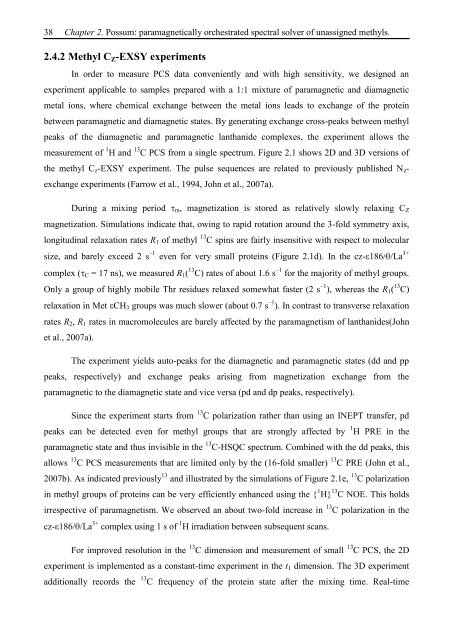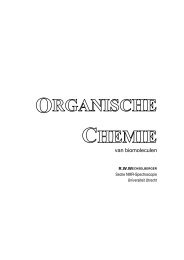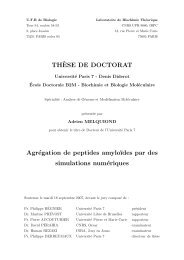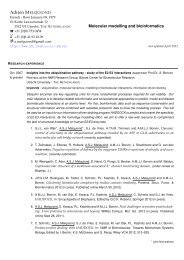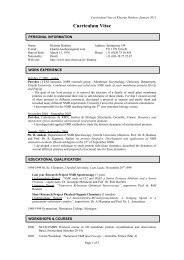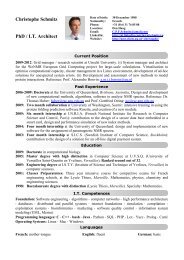Thesis Title: Subtitle - NMR Spectroscopy Research Group
Thesis Title: Subtitle - NMR Spectroscopy Research Group
Thesis Title: Subtitle - NMR Spectroscopy Research Group
Create successful ePaper yourself
Turn your PDF publications into a flip-book with our unique Google optimized e-Paper software.
38 Chapter 2. Possum: paramagnetically orchestrated spectral solver of unassigned methyls.<br />
2.4.2 Methyl CZ-EXSY experiments<br />
In order to measure PCS data conveniently and with high sensitivity, we designed an<br />
experiment applicable to samples prepared with a 1:1 mixture of paramagnetic and diamagnetic<br />
metal ions, where chemical exchange between the metal ions leads to exchange of the protein<br />
between paramagnetic and diamagnetic states. By generating exchange cross-peaks between methyl<br />
peaks of the diamagnetic and paramagnetic lanthanide complexes, the experiment allows the<br />
measurement of 1 H and 13 C PCS from a single spectrum. Figure 2.1 shows 2D and 3D versions of<br />
the methyl Cz-EXSY experiment. The pulse sequences are related to previously published Nz-<br />
exchange experiments (Farrow et al., 1994, John et al., 2007a).<br />
During a mixing period m, magnetization is stored as relatively slowly relaxing CZ<br />
magnetization. Simulations indicate that, owing to rapid rotation around the 3-fold symmetry axis,<br />
longitudinal relaxation rates R1 of methyl 13 C spins are fairly insensitive with respect to molecular<br />
size, and barely exceed 2 s –1 even for very small proteins (Figure 2.1d). In the cz- 186/ /La 3+<br />
complex ( C = 17 ns), we measured R1( 13 C) rates of about 1.6 s –1 for the majority of methyl groups.<br />
Only a group of highly mobile Thr residues relaxed somewhat faster (2 s –1 ), whereas the R1( 13 C)<br />
relaxation in Met CH3 groups was much slower (about 0.7 s –1 ). In contrast to transverse relaxation<br />
rates R2, R1 rates in macromolecules are barely affected by the paramagnetism of lanthanides(John<br />
et al., 2007a).<br />
The experiment yields auto-peaks for the diamagnetic and paramagnetic states (dd and pp<br />
peaks, respectively) and exchange peaks arising from magnetization exchange from the<br />
paramagnetic to the diamagnetic state and vice versa (pd and dp peaks, respectively).<br />
Since the experiment starts from 13 C polarization rather than using an INEPT transfer, pd<br />
peaks can be detected even for methyl groups that are strongly affected by 1 H PRE in the<br />
paramagnetic state and thus invisible in the 13 C-HSQC spectrum. Combined with the dd peaks, this<br />
allows 13 C PCS measurements that are limited only by the (16-fold smaller) 13 C PRE (John et al.,<br />
2007b). As indicated previously 13 and illustrated by the simulations of Figure 2.1e, 13 C polarization<br />
in methyl groups of proteins can be very efficiently enhanced using the { 1 H} 13 C NOE. This holds<br />
irrespective of paramagnetism. We observed an about two-fold increase in 13 C polarization in the<br />
cz- 186/ /La 3+ complex using 1 s of 1 H irradiation between subsequent scans.<br />
For improved resolution in the 13 C dimension and measurement of small 13 C PCS, the 2D<br />
experiment is implemented as a constant-time experiment in the t1 dimension. The 3D experiment<br />
additionally records the 13 C frequency of the protein state after the mixing time. Real-time


